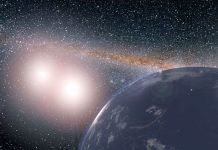
In a remarkable turn of events, astronomers have rediscovered a galaxy that was once visible, then seemingly disappeared, and has now been spotted again by the advanced James Webb Space Telescope (JWST).
This galaxy, named AzTECC71, was first seen as a vague, glowing shape by telescopes on Earth. Surprisingly, it vanished in images taken by the Hubble Space Telescope.
However, JWST has brought it back into view, revealing its true nature.
AzTECC71 is what scientists call a dusty star-forming galaxy. It’s a place where new stars are born at an astonishing rate, hidden behind a curtain of cosmic dust.
This galaxy is from a time nearly 1 billion years after the Big Bang, an era we are just beginning to understand.
Initially, galaxies like AzTECC71 were thought to be rare in the early universe.
But this discovery, along with over a dozen similar galaxies found in initial data from the COSMOS-Web project, suggests that these dust-shrouded star factories might be more common than we believed.
Jed McKinney, a researcher from The University of Texas at Austin, describes AzTECC71 as a “real monster.”
Despite appearing as a small blob, this galaxy is forming hundreds of stars each year. Its detection by JWST, the most sensitive telescope to date, hints at a whole group of galaxies that have evaded our observation until now.
This revelation could change our understanding of the early universe, indicating it was dustier than previously thought.
The COSMOS-Web project, led by Caitlin Casey, also from The University of Texas at Austin, is the largest initial JWST research initiative.
Its goal is ambitious: to map up to 1 million galaxies in a part of the sky as big as three full moons. This effort aims to unravel the mysteries of the universe’s earliest structures.
The team, with over 50 researchers, was granted 250 hours of observing time on the JWST in its first year. They received the first batch of data in December 2022, with more expected until January 2024.
One challenge with studying galaxies like AzTECC71 is their invisibility in optical light. The dust surrounding these galaxies absorbs the light from their stars and re-emits it at longer, redder wavelengths.
Before JWST, such galaxies were often called “Hubble-dark galaxies” because they were too obscured for the Hubble Space Telescope to see. JWST’s advanced capabilities in the infrared spectrum have allowed astronomers to peer through this dusty veil.
AzTECC71 was first detected by the James Clerk Maxwell Telescope in Hawaii as a dust emission. Further observations by the ALMA telescope in Chile narrowed down its location.
JWST’s infrared imaging at 4.44 microns finally revealed the faint galaxy, invisible at shorter wavelengths.
The JWST’s sensitivity allows for unprecedented studies of these dust-enshrouded galaxies, providing a new perspective on the evolution of galaxies in the early universe.
The discovery of AzTECC71 and its kin marks a significant step in our cosmic exploration, revealing a hidden chapter in the story of our universe.
Source: University of Texas at Austin.



